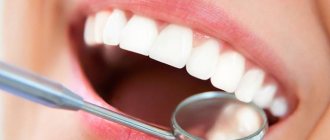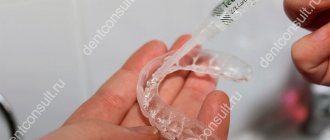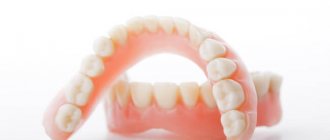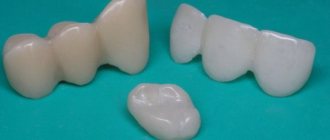What is the difference between a crown and a veneer?
Experts classify both crowns and veneers as orthopedic dentistry, which deals with dental prosthetics. If we talk about the purpose, then in the conventional orthopedic chain “crown-inlay-veneer” the last product is primarily intended to create aesthetics, while crowns and inlays are needed to primarily restore the functionality of the tooth. In dentistry, a separate category is allocated for veneers - microprosthetics, which well reflects the most important visual difference between veneers and crowns. A crown completely copies the entire visible part of a tooth, while veneers model only its outer (vestibular) side.
What veneers and crowns have in common is the fact that both are made in a dental laboratory, but this does not apply to direct composite onlays. In their case, the need for a laboratory stage is eliminated: the application of the composite material is carried out directly in the patient’s mouth, so the procedure does not require taking impressions and is considered an artistic restoration. As for manufacturing materials, there is great variability in crowns. Both designs can be produced from ceramics and zirconium dioxide. However, zirconium veneers are rarely used: zirconium does not adhere well to the teeth, requires significant grinding and looks unnatural.
Main differences
Both types of prostheses are used in orthopedic dentistry for prosthetic restoration of damaged elements.
Veneers are very thin sheets that are glued to the front surface of the damaged unit. They close the existing defect, so the smile begins to look aesthetically pleasing. However, they are not able to completely restore the functions of the tooth. They only replace its visible part to get a good visual result.
Dental crowns are restorations that cover the visible portion of an incisor/molar tooth. Outwardly, they resemble caps with thin walls. They are glued onto a previously prepared stump using special cement.
What is better - veneers or crowns?
Talking about which is better (veneers or crowns) is like comparing a car and a motorcycle. Each of these methods has its own advantages and indications for use. Below is a table that shows situations when it is most preferable to use crowns and when to use veneers.
| Indications for installation of veneers | Indications for crown installation |
|
|
By and large, crowns and veneers have different indications for installation, however, there are situations in which the patient can choose between two products.
Therapeutic effect of use
For patients with uneven teeth, the effect they get after using the straightening system is important. Veneers do not correct the position of crooked teeth in relation to the jaw or each other. The effect is cosmetic through the use of plates glued to the visible dentition. The aesthetics of the final visible result depends on the degree of curvature of the teeth. The feasibility of installation is determined by the dentist after examination. If the defect is small, then the use of veneers gives a good cosmetic result.
| Effect of use | Veneers | Braces | Airliners |
| Principle of operation | The plates are attached to the front of the teeth so that visually they appear straight. Although they become crooked, the plates give the effect of straight teeth | The teeth are shifted due to traction in turn in the desired direction (vertical or horizontal) and straightened | The aligner fits tightly to each tooth and exerts slight pressure to move it vertically and horizontally simultaneously. Teeth become straighter |
| Possibility of developing caries | The risk of caries development is minimal | Poor hygiene may lead to the development of caries. | Not visible |
| Effect on enamel, possibility of enamel whitening and remineralization | Veneers hide natural teeth. Remiralization cannot be carried out. The whitening effect occurs due to the color of the plates. | Whitening and remineralization is possible before or after treatment with braces | Remineralization procedures can be performed during treatment, whitening - before or after |
| The result and reversibility of treatment, do teeth change? | Visually, due to the plates, the teeth change, the patient acquires a beautiful smile. The treatment is irreversible, you need to wear veneers constantly. In the future, replace them with new ones or install crowns | The shape of the teeth does not change, they become even. Curvature may be partially possible again due to improper care if the dentist’s recommendations are not followed | The teeth are straightened, but remain in their original natural shape. If the patient does not take care of his teeth or does not follow the dentist’s instructions to maintain the effect of treatment, some of the teeth may become crooked again. |
| Is rehabilitation necessary after treatment? | No | Using retainers (aligners) at night to consolidate the effect | The use of retainers is indicated to maintain the resulting effect. |
When is the best time to install crowns?
- With significant tooth decay.
From a functional point of view, crowns are considered a more reliable method, so it is better to cover serious chips and damage with crowns. In addition, veneers are strictly not recommended for pulpless teeth. - Frequent participation in contact sports.
If you cannot imagine your life without hockey, basketball or martial arts, it is better to choose more durable crowns to restore your teeth. - Bruxism and the habit of chewing on foreign objects.
In this case, installing veneers is very risky, but even crowns are not able to withstand such loads for a long time, so you need to get rid of bad habits or consult a doctor to treat bruxism.
Photos before and after installation of veneers
Stage of preparation for treatment
In any orthodontic intervention, it is necessary to take imprints (impressions) of the teeth to construct a three-dimensional model of the jaws, which allows the computer to predict the outcome. Some clinics offer digital scanning when creating a 3D model for aligners.
| Stages | Veneers | Braces | Aligners |
| Creation of a three-dimensional computer model to predict treatment outcomes | 3D modeling allows you to see the result in perspective | The doctor creates a 3D model, the opportunity to see the result with or without removing the eights | Yes |
| Participation of the patient in the discussion of the treatment process and in itself | Participates in choosing the color, shape and material of veneers, but the patient does not participate in the treatment | Does not participate in the discussion of the treatment process or in the treatment itself; the doctor independently, according to indications, corrects the direction of change in the location of the teeth in the jaw | Discusses the course of treatment and its prospects with the doctor, and also participates in treatment, changing aligners, as well as using them all the time |
| Production time | Depending on the material from one day to one month | One or two days | One week |
| Preparing your teeth | Hygienic cleaning is carried out, caries is treated, the enamel is ground down by 0.3-0.7 mm | Plaque and stones are removed, and the enamel is polished for better contact with braces. | Cleaning from stone and plaque |
| Care | Dietary adherence to coloring and solid foods must be changed after approximately 5-10 years | Maintaining hygiene, regular cleaning, using a mouthguard after removing braces at night to consolidate the effect | Cleaning, constant wearing (20-22 hours a day) except during meals, no restrictions on food intake (you just need to remove the aligners) |
| Installation time | One veneer is installed in one hour (with more teeth, more time is required) | Takes up to six hours | One hour |
When is the best time to install veneers?
- For small defects in the front teeth.
Unlike crowns, veneers require minimal grinding of the teeth, so the tooth retains its anatomical shape. By the way, it is no longer possible to install veneers after crowns; - To hide small interdental spaces and curvatures.
Veneers cope well with such problems and do not require deep tooth preparation.
When restoring chewing teeth, crowns should be installed, as they cope well with the chewing load. Veneers are placed on molars if they want to get an additional lifting effect for the lower third of the face.
Braces
Braces, aligners, plates are a tool for correcting uneven teeth and bites. Bite is the position of the teeth on the upper and lower dentition relative to each other when the jaws are closed. An orthodontist is involved in correcting the bite.
Braces or mouthguards move teeth into the correct position: they can eliminate crowding, place dystopic or impacted teeth in the dentition, and straighten the bite.
Stages of treatment with braces:
- Diagnostics (images, casts, photo protocol, preparation of a treatment plan)
- Complete sanitation of the oral cavity (treatment of inflammation, caries, pulpitis, etc.)
- Professional hygiene before installing braces
- Fixing braces on teeth
- Orthodontic treatment (on average - 1.5-2 years, from 10 to 20 visits to the orthodontist to activate the system)
- Retention period (installation of a permanent retainer on the inside of the teeth and wearing a transparent mouthguard to fix the correct position of the teeth)
Are veneers used on crowns?
“Is it possible to put veneers on a crown?” — this question is so popular among patients that it has to be discussed separately. The answer here is obvious: veneers are NOT used on crowns. These products are self-sufficient, so such a “mix” makes no sense at all. Repair of crowns is possible, although replacement of the product is more often recommended. Crown restoration is carried out both in the laboratory (the crown is removed beforehand) and directly in the patient’s mouth. The whole procedure is reminiscent of a filling, when the damaged area is filled with a composite material. Veneers cannot be repaired: if the lining breaks, it is replaced with a new one. The exception is direct composite veneers, which can theoretically be restored.
Impact on enamel, teeth and soft tissues of the oral cavity. The advantage of aligners
Treatment of crooked teeth is carried out in the oral cavity and can have a negative effect on them and the mucous membrane. It is a known fact that when treated with braces, it is necessary to remove all eights, which is painful. They are removed one by one, the restoration process takes some time. The patient views the removal of four teeth at once as negative. In the case of treatment with aligners, removal is not performed.
Here is a comparison table
| Impact | Veneers | Braces | Airliners |
| Effect on teeth, is removal necessary? | According to indications (if the figure eights grow crookedly and affect the roots of neighboring teeth, they need to be removed) | In most cases, eights are removed | There is no need to remove figure eights, all teeth are gradually aligned |
| Impact on enamel before and after treatment | The enamel is ground down for better adhesion of the plates to the natural surface. Grind down to 0.3-0.7 mm. The process is irreversible, teeth cannot be left without veneers, veneers are replaced with new ones after the expiration of the period of use according to indications | The enamel is only subjected to cleaning from plaque and stones - hygienic cleaning. Enamel may be damaged during treatment due to poor hygiene | No impact on enamel, hygienic cleaning of plaque and stones before using mouth guards |
| Separation | It is produced to ensure better contact with the plates and the effect of straight teeth. | According to indications, it can be mechanical - grinds down to 0.25 mm of enamel on the sides, or physiological (when metal spacers are used, installed temporarily to create space between the teeth) | According to indications, before wearing mouth guards |
| Risk of injury to mucous membranes and intimate areas | No, safe, imitation of natural ones | Vestibular or lingual metal braces affect the inner surface of the cheeks or tongue and can injure the intimate parts of the partner’s body. Insufficient hygiene poses a risk of infection | No, they are removed when necessary |
Contraindications for ceramic veneers
Ceramic veneers can be placed on teeth from the moment when the permanent bite is fully formed, that is, for patients over 18 years of age. However, the decision to undergo veneering should always be balanced and deliberate. The general list of contraindications is as follows:
- Large fillings on front teeth
- Extensive carious lesions
- Gingivitis
- Periodontitis
- Malocclusions
Several popular questions that confuse patients from the “Is it true?...” series
1. There will be food getting and getting stuck between the veneer and the tooth.
No. With high-quality treatment, the veneer adheres to the entire surface of the tooth, without any gaps for food to enter.
2. Veneers can harm human health.
No. They are made from high-quality materials (both composite and ceramic), which cannot affect health in any way, does not provoke allergic reactions, and is absolutely biocompatible with the body.
3. Veneers can be installed on all teeth, including chewing teeth.
No. Veneers are made and installed only in the visible smile area. Installing them on the external surfaces of chewing teeth is not only impractical, but also fundamentally incorrect, since there is a completely different force of chewing load there.
4. Veneers are painful.
No. Again, if we are talking about appropriately qualified specialists. Starting from tooth preparation and continuing with further installation steps, everything happens with the use of high-quality anesthetics. With proper, qualified installation, there is no pressure on the gums, there is no need to get used to them, everything happens naturally.
5. Teeth look unnatural.
No. A competent specialist will always discuss the color of your future teeth with you and, for his part, will always give a recommendation and comment on whether it will look great or is worth another thought.
Classification of structures
Microprostheses are distinguished by the type of material used in their manufacture. Ceramic veneers, without impurities, are considered traditional. For example, porcelain or pressed ceramics. The advantage of these plates is their impeccable aesthetics. The veneers look natural and neat on the teeth. But ceramics are far from the most durable material. It is not able to withstand significant chewing load.
To increase strength, dentistry has developed zirconium dioxide veneers. In this case, the microprosthesis consists of two layers: a zirconium base and a ceramic lining. Dental crowns are made using the same principle. Important: these plates are metal-free. It is not zirconium (metal) that is used here, but zircon, a natural white mineral. The stone has increased hardness, which allows it to be used to restore lateral teeth. However, the aesthetics of zirconium plates are far from perfect, so after production, an additional layer of ceramic is applied to the veneers. The result is durable ceramic veneers with enamel identical to natural teeth.
The third group includes lumineers - ultra-thin plates. The thickness of the onlays does not exceed 0.2-0.3 mm, which minimizes the process of grinding the teeth. The use of lumineers allows you to hide flaws in the dentition, while preserving the enamel of your natural teeth. The minimum thickness does not affect the functionality of microprostheses in any way. The plates can withstand full chewing load, without chips or cracks. However, there is also a downside: the manufacture and installation of ultra-thin veneers is similar in complexity to jewelry work. High qualifications of both the dental technician and the dentist are required. Which leads to an increase in the cost of the procedure. The cost of making lumineers can be 3-4 times higher than traditional porcelain veneers.
Installation age
Braces
Braces can be installed after the age of 12, when all baby teeth have fallen out. To correct the bite of children under 12, plates and removable mouth guards are used. There is no upper threshold - braces are effective in correcting bites in adults as well. The treatment period in this case increases from six months to 1–2 years.
Braces for a child
Veneers
Veneers are permanent, so they can only be placed after the age of 18–20, when the jaw stops growing. If you place them earlier, the teeth may move a little further apart, and the aesthetic effect of the veneers will disappear. There is no upper limit either.
Braces can be installed in childhood, veneers are only suitable for adults.
Dental hygiene with braces and aligners. The advantage of aligners
| Hygiene measures | Veneers | Braces | Airliners |
| Frequency and cleaning process itself | It is necessary to regularly brush your teeth and rinse your mouth every time you eat, the process is no different from caring for natural teeth. | At the end of your main meal or snack, you need to not only rinse your mouth, but also clean the space between. | Twice a day. Rinsing after snacks is recommended. Maintenance is easy - two minutes twice a day for basic hygiene and 30 seconds for rinsing. |
| Cleaning products, toothpicks | A regular brush is enough to clean your teeth; in addition, you can use floss, irrigator, and a toothpick if necessary. | In addition to a regular brush, you must have a mono-beam brush, a brush, an irrigator, dental floss, and a toothpick! | A brush with toothpaste cleans teeth, irrigator, floss, rinse as desired and necessary |
| Frequency of brush replacement and availability of additional hygiene products | It must be replaced every three months; it is recommended to use a standard one. | It needs to be changed every three weeks, as well as a set of additional brushes that need to be used in the places between the arch and the teeth | One for three months, a regular one is suitable for use |
With the low cost of braces during installation, there is a need to purchase additional hygiene products that need frequent replacement. Teeth with braces are the most finicky to care for; they need to be cleaned after every meal. Use not only a brush, but also a brush and thread. Time is wasted on cleaning hard-to-reach places; if hygiene is neglected, an unpleasant smell will not take long to appear.
Veneers do not require complex care, but they do need to be treated with care. Rough and hard food harms the plates. There is a possibility that part of the veneer may chip, or it may fall off the tooth. In this case, you need to urgently go to the doctor for correction. The disadvantage of veneers is that they are a way to aesthetically change the smile, but not straighten the teeth themselves. To install, you need to grind off the enamel, and the teeth will not be the same. It is important to remember that now the teeth need protection, the installation of plates or crowns.
Aligners and braces correct teeth and correct them. The convenience of aligners is that they can be removed for meals, they are transparent, and the patient does not experience pain in them. The wearing period is shorter than that of braces. The advantage is convenience in everyday life.
Patient reviews
Braces
Reviews about braces in adults are quite contradictory. Many people are satisfied with the results, and wearing modern braces usually does not cause inconvenience. Those who wear ceramic or sapphire braces note their high aesthetics - often the structures are not even noticeable during a conversation. Lingual braces are also popular, especially among public people, although even in positive reviews people note that it is difficult to get used to them.
There are also negative reviews about braces. People generally do not like the length of treatment, the pain in the first few weeks and the trauma to the mucosa. In addition, some write that even when wearing a retainer, the teeth still move slightly apart. And if you don’t wear a retainer, the bite quickly returns to its previous state, and you have to be treated again.
Veneers
Reviews about veneers are almost entirely positive. They are often placed to make teeth whiter, but there are also those who use them to slightly correct their bite, for example, to close a diastema. People especially like the immediate results and the fact that veneers are very comfortable to wear.
Patients consider the high price to be their only drawback. In addition, it is worth considering that they are simply not used by people with serious bite defects, since they will not help in this situation.











